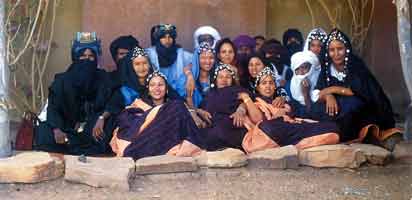 Les Touaregs,
qui se dénomment eux mêmes Kel Tamassheq, vivent dans cinq pays africains;
l'Algérie, la Libye, le Mali, le Niger et Ie Burkina Faso. Autrefois,
Leur base économique était l'élevage, aujourd'hui, ils font de l'agriculture
et sont eu partie sédentaires, lls sont devenus célèbres par leurs
coutumes, en particulier par les hommes qui portent un voile et aussi
à cause de leur réputation légendaire de guerriers téméraires. Leur
écriture, le tifinagh, dérive de l'ancien alphabet libyen, elle est
formée de signes parfaitement géométriques, La société touarègue est
divisée en castes ou les nobles, les guerriers et les savants coraniques
tiennent la première place.
Les Touaregs,
qui se dénomment eux mêmes Kel Tamassheq, vivent dans cinq pays africains;
l'Algérie, la Libye, le Mali, le Niger et Ie Burkina Faso. Autrefois,
Leur base économique était l'élevage, aujourd'hui, ils font de l'agriculture
et sont eu partie sédentaires, lls sont devenus célèbres par leurs
coutumes, en particulier par les hommes qui portent un voile et aussi
à cause de leur réputation légendaire de guerriers téméraires. Leur
écriture, le tifinagh, dérive de l'ancien alphabet libyen, elle est
formée de signes parfaitement géométriques, La société touarègue est
divisée en castes ou les nobles, les guerriers et les savants coraniques
tiennent la première place.
Viennent ensuite les vassaux, également appelés imrad, qui autrefois
devaient payer un tribut aux nobles, Les esclaves, Ies iklan, provenaient
des expéditions contre les populations noires africaines.
Ce groupe devait effectuer tous les travaux et s'occuper du bétail.
Ils sont maintenant libres et se sont beaucoup mieux adaptés aux changements
structurels que leurs anciens maîtres. Au tout dernier étage et hors
de leur société se trouvent les forgerons, les enaden, très craints
à cause de leur capacité à maîtriser le feu. La femme touarègue, la
targia, est étonnamment libre, elle peut divorcer et choisir elle
même son mari.
Repères
historiques
La répression de la rébellion de 1963 va provoquer le premier courant
migratoire des populations touaregs vers l'Algérie. Les effets cumulés
de la sécheresse de 1973-74 vont entraîner un exil massif vers les
grandes villes du maghreb et de l'Afrique subsaharienne.
Si la diaspora semble se construire autour de l'urbanité, l'exil est
marqué par l'errance. Les jeunes Touaregs de la diaspora abandonnent
pour la plupart l'élevage, et alternent travail précaire et chômage.
On les désignera désormais sous le nom d'Ashamour (au pluriel, Ishoumar),
altération berbère du mot français chômeur.
Les générations de l'exil vont élaborer une nouvelle réflexion politique,
dont l'aboutissement serait la lutte pour une justice sociale pour
le peuple touareg.
En 1990, le mouvement issu du Mali débute la rébellion. Le 11 avril
1992, un pacte national est signé entre le gouvernement malien et
les mouvements rebelles. Ce n'est finalement qu'à l'aube de l'an 2000
que le pays touareg des Ifoghas s'ouvre peu à peu au monde.
 Les
Touaregs au Mali
Les
Touaregs au Mali
Le Mali, avec Bamako pour capitale, est un des pays les plus pauvres
d'Afrique. Ce pays d'Afrique de l'Ouest d'une superficie de 1,2 millions
de km² est un des cinq pays dans lesquels vivent les Touaregs. La
plupart des Africains noirs du peuple malien, les Bambaras et les
Songhaïs, vivent au sud le long des fleuves et pratiquent l'agriculture.
Les deux-tiers de cet immense pays fait partie des régions désertiques
et semi-désertiques au nord desquelles vivent, comme nomades et semi-nomades,
les Touaregs à la peau claire et les Maures, appelés aussi "les Maliens
blancs". Ils ne représentent environ que 6% de la population totale
et se concentrent dans les régions de Tombouctou, Kidal et Gao.
En
1990, un massacre des Touaregs au Niger conduisit à une révolte armée
qui s'étendit rapidement au Mali. Les terribles sécheresses des années
1974 et 1984 durant lesquelles les nomades perdirent une grande partie
de leurs troupeaux et ainsi leur seule base de subsistance furent
à l'origine de ce conflit. Plusieurs milliers d'entre eux moururent
de faim, de nombreux autres fuirent la misère danles pays voisins.
L'aide alimentaire promise par l'étranger disparut dans les poches
des politiciens corrompus et réapparut sur les marchés du sud. Presque
tous les postes administratifs et politiques importants sont occupés
par les Bambaras et les Songhaïs, à la suite du refus des Touaregs
de donner à leurs enfants une formation scolaire, Au lieu de cela,
pendant la période coloniale ils envoyèrent à l'école les enfants
de leurs anciens esclaves, les Noirs. Ce qui leur assura par la suite
un avantage décisif.
La
guerre civile du Mali, provoquée en première ligne par le non développement
sciemment et intentionnellement voulu par le Nord, la destruction
des troupeaux par les sécheresses, l'inégalité sociale et la répression
gouvernementale, dura cinq ans et laissa derrière elle une, terre
dévastée. Des centaines de milliers fuirent la violence en Algérie,
au Burkina Faso et en Mauritanie où ils végétèrent dans des conditions
épouvantables. C'est seulement sous le Président Konaré que les buts
du traité de paix se concrétisèrent et semblent actuellement assures
au Mali. Les réfugiés sont retournés en grande partie dans leur pays
d'origine, les anciens rebelles ont été intégrés à l'armée régulière
et l'infrastructure été rétablie (protection médicale, constructions
de fontaines, d'écoles, reconstitution des terres cultivables et du
cheptel). Les Touaregs eux-mêmes se tournent de plus en plus vers
l'agriculture, ils s'associent à des coopératives et ouvrent des commerces
au moyen depetits crédits. Et cependant, comme depuis des siècles,
une partie d'entre eux voyage de nouveau à travers le désert.
Petra
Bode Traduit par Isabelle Jue